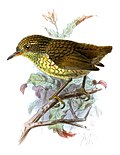| Caligavis | |
|---|---|
 | |
| Caligavis chrysops (yellow-faced honeyeater) | |
| Scientific classification | |
| Kingdom: | Animalia |
| Phylum: | Chordata |
| Class: | Aves |
| Order: | Passeriformes |
| Family: | Meliphagidae |
| Genus: | Caligavis Iredale, 1956 |
| Type species | |
| Ptilotis obscura [1] De Vis 1897 | |
Caligavis is a genus of honeyeaters endemic to New Guinea and Australia. It includes former members of Lichenostomus , and was created after a molecular phylogenetic analysis published in 2011 showed that the original genus was polyphyletic. [2]

